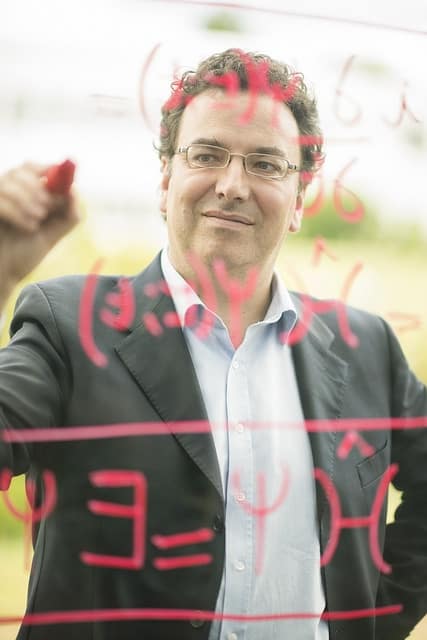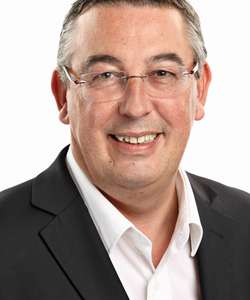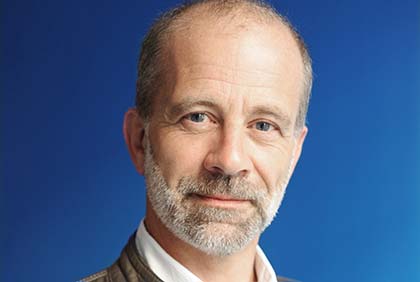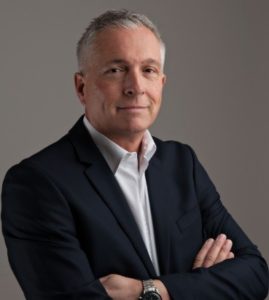On 13 July 2018 Physics World industry editor Margaret Harris will be moderating a panel discussion at the European Science Open Forum in Toulouse, France on “Engineering Eureka: How can industry best engage with fundamental research”? Ahead of the discussion, she asked panel members to reflect on their own firms’ connections with basic research. Their replies have been edited for length and clarity.

Alessandro Curioni, vice-president, IBM Europe and director of the IBM Research Lab in Zurich, Switzerland
We have been pushing basic research as a way to create transformational innovations for our company for 60 years. Within Europe, IBM is participating in more than 90 Horizon 2020 projects on a diverse set of topics, and we are collaborating with more than 900 institutions. Within these projects, I would say that 20–30% could be considered “blue-sky” research, where it’s not just about creating better products or services, but eventually creating completely new businesses or transforming some that we already have. An example is quantum computing. We have been investing in that area for more than 30 years, starting from fundamental research, and without that work we would not have an IBM quantum computer on the market today.
It’s very difficult to quantify the impact of basic research. You can do it only if you accept that basic research has a value per se.
Alessandro Curioni, IBM
Another area where we have been involved in basic research is in scanning-tunnelling microscopy (STM). When it was developed, STM was really a very basic tool to understand the nanoworld, but today, it’s the basis of nanotechnology and it will allow us, for example, to come up with new neuromorphic-analogue types of computing that will probably be the base of the computing of tomorrow.
To do this, I think you need to have a very wise and future-looking style of management within your company. Basic research is not something that brings results the next day. If you lose that longer-term view from management, there is a big risk that your manager might tell you that what you are doing is not bringing any value for the next couple of quarters, and so you don’t move forward. We are also seeing this in government institutions and universities, because there is more of a move to ask for “impact”. When the focus is always on the return, that can create barriers, because then the people who are doing basic research have to come up with constructs that are very artificial to try to explain why basic research is important and has “impact”.
The reality is that at a given moment, it’s very difficult to quantify the impact of basic research. You can do it only if you accept that basic research has a value per se, and if you have the right culture, you understand that whatever brings you success today has come from investment many years before. I think the European Commission’s more “mission-oriented” funding programmes are helpful in this sense, because if you have a high-level mission, then within this you can find space for contributions from across the spectrum between basic and applied research, and the boundaries disappear.

Thierry Botter, head of Airbus Blue Sky
Until last year, Airbus’ central R&T (CRT) organization and divisional R&T organizations were very much involved in applying for publicly-funded research projects. However, following a comprehensive reorganization of our central entity, the decision was made to no longer seek public funding within CRT. The decision was motivated by several factors, including the low probability of success. Substantial time and effort would be invested by CRT members to set up collaborations that were relevant for Airbus’ future capabilities and met strict organizational conditions established by the funding body, but with only a limited success rate, the company deemed this effort not worthwhile.
In addition, there is a time lag in these public projects. By the time the project proposal is put in, feedback is returned, the project is kicked off, and the results come in, it may be years later, and the company’s direction or focus might have shifted. This disconnect between our immediate needs and desires for quick, short-term action was also part of the decision to move us away from publicly funded initiatives.
We at Airbus Blue Sky are curious to see how we can take concepts and principles from neuroscience, how the human brain works and interprets its environment, and use them for the benefit of aerospace-relevant applications – drones, for example.
Thierry Botter, Airbus
Now, we are instead focusing our activities in a few key sectors, and a few key topics within those sectors, and we are self-funding them: we define the activity we want to undertake, we identify partners and we try to collaborate with them. We have also set up my department, Airbus Blue Sky, to focus on very long-term research, tied to basic science, with a very wide range in terms of what topics it can explore. This department is now officially six months old, and over those six months we’ve begun to engage with a few different topics. Notable examples include quantum computing, quantum communication and quantum sensing, but also computational neuroscience, which is a discipline that overlaps with the world of artificial intelligence. We at Airbus Blue Sky are curious to see how we can take concepts and principles from neuroscience, how the human brain works and interprets its environment, and use them for the benefit of aerospace-relevant applications – drones, for example.
Another area of interest is structural power storage. Can we take an aircraft that has certain structural properties – tensile strength, an ability to resist shocks and vibrations and so forth – and also empower this structure to hold electric charge? It might not be a very large amount of charge, but even a little extra on top might enable certain vehicles to get more mileage out of their trajectory. We’re not going to double the distance an electric aircraft can travel, but we might enable slightly longer ranges or flight times.
Airbus Blue Sky has worked with a variety of partners so far, including small companies, start-ups, academic research teams and national research labs. It really is topic-dependent – who we partner with depends on the topic at hand. The tricky bit, however, is that a lot of our partners are not necessarily familiar with this approach, so the contract negotiations are sometimes difficult. This is one advantage of publicly-funded schemes: people are familiar with the framework agreement for collaborations, and they don’t tend to be as objectionable to legal representatives as doing things on an ad-hoc, per-project, per-company basis. This is one sticking point; it’s not insurmountable, but it’s something that we’ve had to address.

Jean-Luc Beylat, vice-president of global innovation ecosystem partnerships at Nokia Bell Labs and head of Bell Labs France
In my case it’s quite easy to answer this question “How does your company engage with basic research?”, because Bell Labs is the famous research institute which, after various consolidations in the telecommunications industry, is now part of Nokia. The expectation from the Nokia group is that we will not do development or prepare the next phase of Nokia products; instead, our role is to work on fundamental or disruptive science. We have 1500 researchers at different offices around the world, with activities in photonics, cybersecurity, artificial intelligence, data analytics and more, and we work intensively with universities as well.
For us, basic research is critical for two reasons. The first is because there has been an acceleration of the technology cycle. Twenty or 30 years ago we had maybe a few years’ gap between doing the research and going to market with a product, but now it’s even shorter. The other reason is that we really need to anticipate the ways the world is changing, not only at the perimeter of Nokia but more globally. For example, we had an intensive research programme in mathematics to identify advanced algorithms for artificial intelligence, and specifically for applications in deep learning. We did this to give the telecommunications network the capacity to self-optimize, so that the network understands the problems it faces in terms of resource management and traffic, and can optimize the traffic without a specific program to instruct it. On paper it’s quite easy to understand, but in terms of research it’s necessary to have a network “forecast” to anticipate trends.

Marc Rougier, partner at Elaia Partners
We’re a venture-capital fund, so we finance research, which I suppose is sort of a way to engage! Our focus is on super-early-stage technology transfer. We are trying to make start-ups and viable companies out of research, and we have a lot of contacts within academic research, private research and government research to help us identify opportunities to do that. For example, we have a technology-transfer fund that works in partnership with Paris Science and Literature – a group of 24 universities and research institutes within Paris. This group has spun off companies in fundamental physics and biotechnology, and also from mathematicians working on artificial intelligence.
At the moment, especially (but not only) in France, a lot of innovations that happen in the lab either die there, and stay at the level of theoretical research, or they are acquired in one way or another by a larger corporation. We think there is a third way, which is to try to transform some of the researchers into entrepreneurs and help them build companies.
The down side is that by coming in super-early, we are more likely to make no money at all, because the likelihood of a given start-up going all the way down that path is small. However, if it does, we create a lot of value, and that is one reason we’ve adopted this approach. The other is that we really believe there is a gap in financing these things, because research is traditionally financed by mechanisms that are not directly connected to the value of a business. Later on, once a team has been built up, they have a proof of concept and have already signed a handful of clients, anyone will want to finance them. But there is a gap when an idea is no longer pure research, but it’s not yet a viable company. That’s the gap I want to bridge.

Olivier Pfeiffer, head of financial and critical infrastructure markets, ID Quantique
ID Quantique is interesting in that respect because the company was founded by people from the physics department at the University of Geneva, and there’s always been plenty of cross-pollination, with people who work at ID Quantique also teaching or doing postgraduate degrees in the university. On a more practical level, a lot of our products are used by universities, so it helps us to have feedback from researchers on the products, their uses and their interfaces so that we can improve them. Another example is that we recently did a joint project with the University of Toronto and a large Canadian bank. The bank sponsored the purchase of quantum-key-distribution equipment for the university, with the aim of leveraging our equipment and the knowledge of the researchers to become familiar with quantum-key exchange, so that they can potentially install it in their bank later.
One of the challenges is that, as a private company, we’re running on a tighter schedule than most universities, where you might have a whole semester or year to work on a specific project. We have to work around that.



